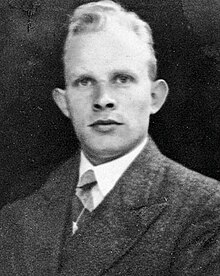Assien Bohmers
Assien Bohmers , born as Johan Christiaan Böhmers , (first name also: Azzien , last name also Bommers , Böhmers or Bëmmers ; born November 16, 1912 in Zutphen , Netherlands; † early May 1988 in Gothenburg , Sweden) was a Dutch archaeologist and geologist in service of the Himmlerian Organization Research Association of German Ahnenerbe .
Life
The different spellings of Bohmers' names arose from his emphasized Frisian nationality awareness and his later work in Germany.
Youth and education
Bohmers was the son of a nurse from Zutphen and Lolkje Uiterwijk from Harlingen. After attending the Hogere Burgerschool (HBS), Bohmers studied geology and paleontology at the University of Amsterdam . During his student days he joined the AJC, the youth organization of the Dutch Socialist Social Democratic Workers' Party ( Sociaal Democratische Arbeiders Partij ). He later worked as a lecturer at the Institute for Biology and Archeology at the University of Groningen .
SS-Ahnenerbe
Bohmers applied to the SS organization Ahnenerbe with a photo and written documents that were supposed to prove his Aryan descent. He gave a Frisian-national attitude; in his ancestors on his mother's side, however, only one Frisian grandmother was detectable.
As a department head for prehistory in the SS organization Forschungsgemeinschaft Deutsches Ahnenerbe , he carried out a number of research expeditions, including 1937–1938 excavations in Bavaria and in July 1939 in Nikolsburg, Austria . The excavations were under the personal supervision of Heinrich Himmler.
They should provide a scientific justification for the National Socialist racial theory of Aryan master people. Bohmers assigned his finds from Germany to the Cro-Magnon people and claimed, as requested, that Germany was the home of the Nordic (Aryan) race. The theses were disseminated at exhibitions in France and Belgium. In 1939, 1941 and 1943 he carried out excavations for the "ancestral heritage" in Dolní Vestonitse in the occupied Reich Protectorate of Bohemia and Moravia at a resting place for Paleolithic (late Pleistocene) hunters after the Czech scholar Karel Absolon came from the excavation and from the Moravian State Museum had been displaced.
After the German occupation of the Netherlands in World War II, Bohmers worked as an advisor to the SS at his own request . In May 1941 , Bohmers completed his habilitation at the University of Vienna .
After the Second World War
After the end of the war he was interned and gave testimony before the Nuremberg Military Court because of his many years of work with the SS-Ahnenerbe .
In the 1960s he participated in the production of fake Frisian rock carvings. The investigation into the case of the amateur archaeologist Tjerk Vermaning finally ended Bohmer's university career. The scientist, who had already been highly controversial, was convicted of unauthorized possession of weapons and left the university in Groningen "in honor" .
Publications
- The excavations in the caves by walls . In: Research and Progress , Vol. 15, No. 14. May 10, 1939, pp. 183-185, ISSN 0367-2794 .
- The Aurignac group. A classification of the oldest art of prehistoric times (supplement to Germania; 3). Ahnenerbe-Stiftung-Verlag, Berlin-Dahlem 1942.
literature
- Michael H. Kater : The “Ahnenerbe” of the SS 1935–1945. A contribution to the cultural policy of the Third Reich . 4th edition. Oldenbourg, Munich 2006, ISBN 978-3-486-57950-5 , ( Studies on Contemporary History 6), (Part. Zugl .: Heidelberg. Univ., Diss., 1966), online .
- Heather Pringle: The Master Plan: Himmler's Scholars and the Holocaust , Hyperion, New York, 2006, ISBN 978-1-4013-8386-2 Digital reading sample (English)
- Heather Pringle: The Master Plan as HarperCollins eBook (English text without images)
- Marc Groenen: Pour une histoire de la préhistoire: le Paléolithique. Jérôme Millon, Grenoble, 1994.
- Karel Valoch: Le paléolithique en Tchéquie et en Slovaquie , No. 3, 1996.
- "Historie" ukradeneho "naleziste. Assien Bohmers a Vykopavky SS-Ahnenerbe V Dolnich Vestonicich ', in: Sbornik Regionalniho, Muzea v Mikolove (2009). Pp. 129-146.
- Arnold Carmiggelt: 'Secret pinnacle is gone'. Assien Bohmers 1912–1988. Biography. Eburon, Utrecht, 2019, ISBN 978-94-6301-239-3 .
Individual evidence
- ↑ Paleo-Aktueel 17: Archeologie in 2005, p. 28
- ↑ The Higher Civic School was a type of secondary school in the Netherlands and the Dutch possessions between 1863 and 1974
- ^ Marc Groenen: Pour une histoire de la préhistoire: le Paléolithique. Grenoble, Jérôme Millon, 1994. p. 415.
- ↑ Heather Pringle: Hitler's Willing Archaeologists. How the SS perverted the Paleolithic record to support Nazi ideology From: Archeology Archive. A publication of the Archaeological Institute of America, Volume 59 Number 2, March / April 2006
- ↑ Gerd Simon: Review of the book Heather Pringle: The Master Plan
- ↑ Michael H. Kater: The "Ahnenerbe" of the SS 1935-1945. A contribution to the cultural policy of the Third Reich . 4th edition. Oldenbourg, Munich 2006, p. 460 .
- ↑ Michael H. Kater: The "Ahnenerbe" of the SS 1935-1945. A contribution to the cultural policy of the Third Reich . 4th edition. Oldenbourg, Munich 2006, p. 461 .
- ^ Garrett G. Fagan: Archaeological Fantasies. London, 2006. p. 167. Review
- ↑ Martin Findell: Vocalism in the Continental runic inscriptions. Thesis submitted at the University of Nottingham for a Doctor of Philosophy degree, September 2009. p. 192. Nottingham ePrints Online
- ↑ Tjerk Vermaning ( Memento from July 14, 2014 in the Internet Archive ) (Dutch) with reference to the memoirs of the former director of the BAI and archaeologist Harm Tjalling Waterbolk : Scherpe stenen op mijn pad . Heveskes Uitgevers, Groningen; ISBN 90-806727-5-0
| personal data | |
|---|---|
| SURNAME | Bohmers, Assia |
| ALTERNATIVE NAMES | Böhmers, Johan Christiaan (maiden name); Bohmers, Azzien; Bëmmers; Bommers; Boehmers |
| BRIEF DESCRIPTION | Dutch geologist and paleontologist |
| DATE OF BIRTH | November 16, 1912 |
| PLACE OF BIRTH | Zutphen , the Netherlands |
| DATE OF DEATH | May 1988 |
| Place of death | Gothenburg |
